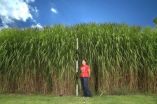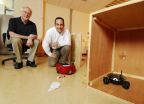(Press-News.org) Laxenburg, Austria – 9th September 2010. Due to increasing life-spans and improved health many populations are 'aging' more slowly than conventional measures indicate.
In a new study, to be published in Science, (10 September) scientists from the International Institute for Applied Systems Analysis (IIASA) in Austria, Stony Brook University, US, (SBU), and the Vienna Institute of Demography (VID) have developed new measures of aging that take changes in disability status and longevity into account.
The results give policymakers faced with growing numbers of elderly new tools to more accurately determine the cost of an aging population and to determine more appropriate retirement ages. Currently, assessments are frequently based on United Nations aging forecasts that include the proportion of the population that is 65 years and older, and the "old age dependency ratio" (OADR), which considers the number of people dependent on others when they reach age 65.
"Those measures are based on fixed chronological ages, and this can generate misleading results," says Dr Warren Sanderson, from IIASA and SBU. "When using indicators that assume fixed chronological ages, it's assumed that there will be no progress in factors such as remaining life expectancies and in disability rates. But many age-specific characteristics have not remained fixed and are not expected to remain constant in the future."
However, many people over 65 are not in need of the care of others, and, on the contrary, may be caregivers themselves. The authors provide a new dependency measure based on disabilities that reflect the relationship between those who need care and those who are capable of providing care, it is called the adult disability dependency ratio (ADDR). The paper shows that when aging is measured based on the ratio of those who need care to those who can give care, the speed of aging is reduced by four-fifths compared to the conventional old-age dependency ratio.
Co-author Dr Sergei Scherbov, from IIASA and the VID, states that "if we apply new measures of aging that take into account increasing life-spans and declining disability rates, then many populations are aging slower compared to what is predicted using conventional measures based purely on chronological age."
The new work looks at "disability-free life expectancies," which describe how many years of life are spent in good health. It also explores the traditional measure of old age dependency, and another measure that looks specifically at the ratio of disabilities in adults over the age of 20 in a population. Their calculations show that in the United Kingdom, for example, while the old age dependency ratio is increasing, the disability ratio is remaining constant. What that means, according to the authors, is that, "although the British population is getting older, it is also likely to be getting healthier, and these two effects offset one another."
New measures of aging that include not just changes in longevity, but accurate numbers about disability rates, "can help educate the public about the likely consequences of improvements in health and longevity," the authors say. And such measures have policy implications because, "slow and predictable changes in pension [retirement] age justified by an increased number of years of healthy life at older ages, may be more politically acceptable than large, abrupt changes justified on the basis of budget stringency."
INFORMATION:
Reference: Sanderson W. C. and Scherbov S. Remeasuring Aging: Science Policy Forum. September 10 2010.
For more information or interviews contact:
Professor Warren Sanderson: International Institute for Applied Systems Analysis (IIASA) Austria and Stony Brook University, USA. Tel: + 1-631-681-2778 Warren.Sanderson@stonybrook.edu
Dr Sergei Scherbov: International Institute for Applied Systems Analysis (IIASA) Austria and the Vienna Institute of Demography. Tel. +43 2236 807 280 or +43 1 515 817 707
mob. +43 676 930 87 13 (from September 5-16 in Moscow, mob: +7 926 704 96 08)
sergei.scherbov@oeaw.ac.at. scherbov@iiasa.ac.at,
Leane Regan: International Institute for Applied Systems Analysis (IIASA) Tel: +43 2236 807 316, Mob: +43 664 443 0368; regan@iiasa.ac.at
About IIASA:
IIASA is an international scientific institute that conducts research into the critical issues of global environmental, economic, technological, and social change that we face in the twenty-first century. Our findings provide valuable options to policy makers to shape the future of our changing world.
IIASA is independent and funded by scientific institutions in Africa, the Americas, Asia, and Europe. www.iiasa.ac.at
Current energy technologies are not enough to reduce carbon emissions to a level needed to lower the risks associated with climate change, New York University physicist Martin Hoffert concludes in an essay in the latest issue of the journal Science.
Many scientists have determined that in order to avoid the risks brought about by climate change, steps must be taken to prevent the mean global temperature from rising by more than 2°C above pre-industrial levels. Current climate models indicate that achieving this goal will require limiting atmospheric carbon dioxide (CO2) ...
An innovative grouping of conservation scientists and practitioners have come together to advocate a fundamental shift in the way we view biodiversity. In their paper, which was published today in the journal Science, they argue that unless people recognise the link between their consumption choices and biodiversity loss, the diversity of life on Earth will continue to decline.
Dr Mike Rands, Director of the Cambridge Conservation Initiative and lead author of the paper, said: "Despite increasing worldwide conservation efforts, biodiversity continues to decline. If ...
The lure of greater profits elsewhere in the world may divert bio-pharmaceutical firms in developing countries from the creation and distribution of affordable drugs, vaccines and diagnostics for illnesses of local concern, undermining the health prospects of millions of poor people, experts warn.
And they call for a series of measures to bolster international support for continuing the success of firms finding homegrown solutions to immediate health concerns in developing countries.
In a commentary published by the journal Nature Biotechnology, researchers Rahim Rezaie ...
University of California, Berkeley, researchers have taken genes from grass-eating fungi and stuffed them into yeast, creating strains that produce alcohol from tough plant material – cellulose – that normal yeast can't digest.
The feat could be a boon for the biofuels industry, which is struggling to make cellulosic ethanol – ethanol from plant fiber, not just cornstarch or sugar – economically feasible.
"By adding these genes to yeast, we have created strains that grow better on plant material than does wild yeast, which eats only glucose or sucrose," said Jamie Cate, ...
NAIROBI (9 September 2010)—Greenhouse gas emissions caused by livestock operations in tropical countries—a major contributor to climate change—could be cut significantly by changing diets and breeds and improving degraded lands, according to a new study published this week in the U.S. Proceedings of the National Academy of Sciences. And as an added bonus, scientists found the small changes in production practices could provide a big payoff by providing poor farmers with up to US$1.3 billion annually in payments for carbon offsets.
"These technologically straightforward ...
Liquid water has interacted with the Martian surface throughout Mars' history, measurements by NASA's Phoenix Mars Lander suggest.
The findings, published in the Sept. 10 issue of the journal Science, also suggest that liquid water has primarily existed at temperatures near freezing, implying hydrothermal systems similar to Yellowstone's hot springs on Earth have been rare on Mars throughout its history.
These surprising results come from measurements Phoenix made in 2008 of stable isotopes of carbon and oxygen in the carbon dioxide of the Martian atmosphere. Isotopes ...
URBANA – In the search for the perfect crop for biofuel production, Miscanthus has become the darling to many. But in an effort to not be charmed by its enormous potential for biomass production, researchers at the University of Illinois are taking a careful look at the pros and cons of its behavior in the field.
A recent study analyzed water quantity and quality in plots of Miscanthus, switchgrass, corn, and soybeans and found that Miscanthus used substantially more water, but reduced the potential for nitrogen pollution to water bodies.
"We found that Miscanthus ...
A robot deceives an enemy soldier by creating a false trail and hiding so that it will not be caught. While this sounds like a scene from one of the Terminator movies, it's actually the scenario of an experiment conducted by researchers at the Georgia Institute of Technology as part of what is believed to be the first detailed examination of robot deception.
"We have developed algorithms that allow a robot to determine whether it should deceive a human or other intelligent machine and we have designed techniques that help the robot select the best deceptive strategy to ...
OTTAWA – September 9, 2010 --- New analysis of a landmark health survey by the University of Ottawa Heart Institute (UOHI) shows that 70% of Ontario adults are either overweight or obese, and have a strong prevalence of high blood pressure that could lead to heart attack or stroke.
The research, led by Dr. Frans Leenen of the Heart Institute's Hypertension Unit, adds new information to a limited amount of Canadian data on obesity and high blood pressure. The analysis further strengthens the link between high blood pressure and above normal Body Mass Index (BMI), a formula ...
AUSTIN, Texas—People are more likely to remember specific information such as faces or words if the pattern of activity in their brain is similar each time they study that information, according to new research from a University of Texas at Austin psychologist and his colleagues.
The findings by Russell Poldrack, published online today in the journal Science, challenge psychologists' long-held belief that people retain information more effectively when they study it several times under different contexts and, thus, give their brains multiple cues to remember it.
"This ...




